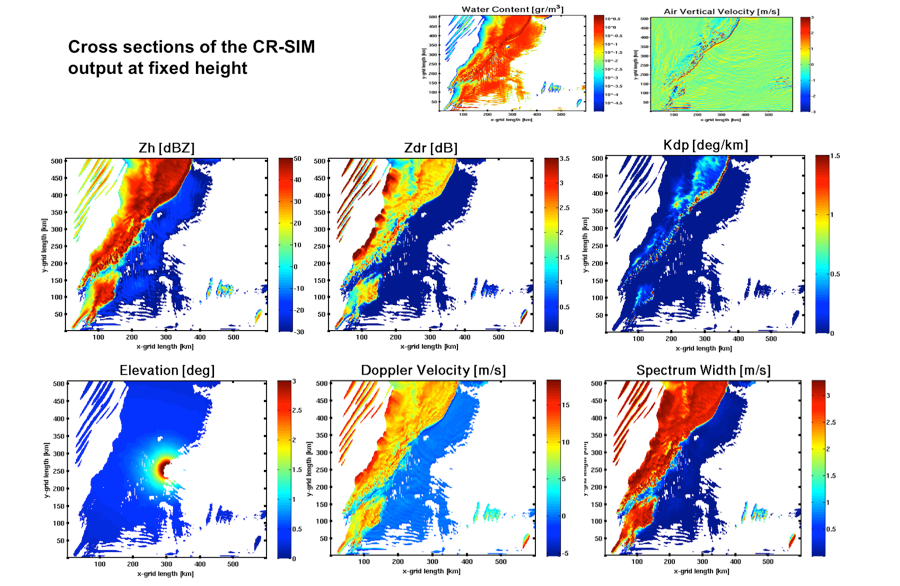Cloud Resolving Model Radar Simulator
The idea behind CR-SIM is to create an accurate radar forward model operator consistent with several microphysics schemes that converts the model variables into the form of radar observations and thus to enable the direct comparison between numerical weather model output and radar observations. The CR-SIM can be applied in order to reproduce characteristic (polarimetric) signatures commonly found in (polarimetric) radar and lidar observations and examine the performance of different microphysical schemes and the assumptions related to scattering characteristics of observed cloud and precipitation systems.

The current version of CR-SIM uses input from the high resolution Weather Research and Forecasting (WRF) Model (WRF) for several microphysical schemes (Morrison double-moment scheme, Milbrandt and Yau double-moment scheme, and the fast spectral bin scheme) and computes “idealized” forward modeled scanning (or vertical-pointing) radar observations and profiling lidar observables. The CR-SIM can be easily configured to work on other models and microphysics schemes. The latest version can use the inputs from the ICOsahedral Non-hydrostatic general circulation model (ICON), the Regional Atmospheric Modeling System (RAMS), and System for Atmospheric Modeling (SAM). The CR-SIM is written in FORTRAN and uses as input the model prognostic mass and number variables in the case of double-moment microphysics schemes or the explicit (bin) microphysics for the fast spectral bin scheme.
The CR-SIM employs the T-matrix method for computation of scattering characteristics for cloud water, cloud ice, rain, snow, graupel and hail and allows the specifications of the following radar frequencies for scattering calculations: 3 GHz, 5.5 GHz, 9.5 GHz, 35 GHz and 94 GHz. For the lidar variable simulations, the T-matrix computation also provides scattering characteristics for cloud water (for ceilometer and micro pulse lider simulations) and cloud ice (for micro pulse lider simulations) at wavelengths of 905 nm for ceilometer and 353 and 532 nm for micro pulse lider.
The polarimetric variables simulated include reflectivity at vertical and horizontal polarization, differential reflectivity, specific differential phase, specific attenuation at horizontal and vertical polarization, specific differential attenuation, and linear depolarization ratio. Also simulated are the vertical reflectivity weighted velocity, mean Doppler velocity and spectrum width. The computation of fall velocities is consistent with the computational method used in the specific microphysical package. The simulated lidar variables includes true and attenuated backscatter, extinction coefficient, lidar ratio, true and attenuated aerosol backscatter, aerosol lidar ratio, and molecular backscatter.
The CR-SIM includes an optional package to emulate additional observational products from the simulated radar and lidar variables. The current version compute liquid water path considering the microwave radiometer field of view and the Active Remote Sensing of Cloud Locations (ARSCL) products.
Version 3.3 is now available (Mar 26, 2020):
The major changes since the last release (v.3.2) of the model include:
- Adapted cloud number concentration and mu for rain in P3 for WRF v4.1.
- Fixed a bug in hydro_icon (max and minimum values for rain mixing ratio at each diameter bin).
- Modified computation of the specific attenuation at horizontal and vertical polarizations to include the dependencies of Ah and Av on the angular moments Improved stability of the software.
- Corrected inconsistencies when using real instead of double precision variables corrected in all files.
- The tolerance for all the tests modified from 1.e-10 to 1.e-4.
- The module wrf_var_mod.f90 copied to module wrf_rvar_mod.f90. Created the new wrf_var_mod.f90 with the same types and subroutines as wrf_rvar_mod.f90 but in double precision. The structures from wrf_rvar_mod.f90 are used for reading the input model data which are then copied and saved to corresponding structures from wrf_var_mod.f90.
- Indentation introduced in ReadInpWRFFile.f90 and ReadInpRAMSFile.f90.
- Added computation of
 .
.
CR-SIM 3.3 is licensed under GNU GENERAL PUBLIC LICENSE (GNU GPL).
If you use the CR-SIM software to simulate WRF data used in publication, an acknowledgment would be appreciated. If you have any comments, suggestions for improvements, bug fixes or you need help to interface CR-SIM with your model output, please contact us:
- aleksandra.tatarevic@mcgill.ca
- pavlos.kollias@stonybrook.edu
- mariko.oue@stonybrook.edu
- diewang@bnl.gov
We would like to thank Dr. H. Morrison, Dr. Z. Feng and Dr. J. Fan, Dr. T. Matsui, and Dr. A. Fridlind for providing the WRF output data and for their valuable comments, suggestions and encouragement. Thanks are extended to Dr. M. Mech, Dr. P. Marinescu, and Dr. T. Yamaguchi for providing the ICON, RAMS, and SAM output data, respectively, and for their valuable comments. We also would like to thank Dr. J. Vivekanandan for his Mueller-matrix-based code and Dr. M. I. Mishchenko for making his T-matrix codes public and freely available for research purposes.


